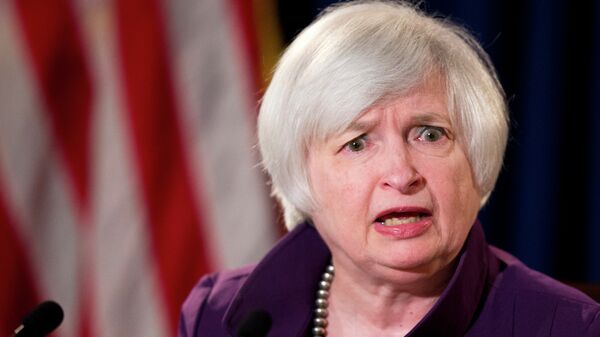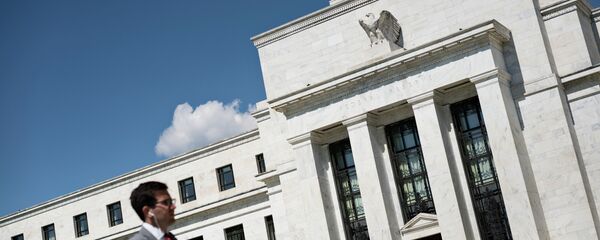Kristian Rouz – The US Federal Reserve raised base borrowing costs on Wednesday by 0.25 percent to 1.25 percent as Fed Chair Janet Yellen expressed confidence that the solid labor market will stoke domestic inflation and economic expansion in the near-term. However, the batch of macro data for May was a disappointment, reflecting the weakening demand side of the economy.
Such a central bank agenda would require a quicker pace of interest rate hikes at all costs. It was the second Fed rate hike this year and the fourth since the regulator started the post-Great Recession monetary tightening cycle in December 2015.
Yellen said the weakening in US inflation observed in May is only temporary, and that inflation will stay at the targeted 2-percent level in the near-to-medium-term, counting in further interest rate increases.
"Near-term risks to economic outlook appear roughly balanced, but the committee is monitoring inflation developments closely," the Federal Open Market Committee (FOMC) said.
US consumer prices, according to a report from the US Labor Department, unexpectedly dropped by 0.1 percent in May following a 0.2-percent increase the previous month. Annualized inflation rose by 1.9 per cent in May, almost in line with the Fed target, but consumer price growth is still insufficient to support the view that the June interest rate hike was appropriate, according to the data-based approach that the Fed had practized for many years following the Great Recession.
Core US Consumer Price Index (CPI), which is inflation excluding food and energy prices, rose just 1.7 percent year-on-year in May compared to a gain of 2 percent the previous month.
For its part, the Commerce Department said US retail sales extended their decline in May, having fallen by 0.3 percent after a 0.4-percent contraction the previous month, mainly due to the contraction in automobile sales. Annualized retail sales are still in the positive territory, at 3.8 percent in May, but the month dynamics suggest that the looming auto loan bubble is starting to weigh on the overall performance of the demand side of the economy.
Wednesday’s interest rate hike was thus not motivated by the macro data, but rather by policy considerations. Despite the ongoing gradual pickup in global economic growth, there are significant headwinds to the US economy, stemming from the risks associated with the structural economic reform planned in the White House, more protectionism, and the looming shifts in domestic sources of growth.
In this light, the Federal Reserve needs additional crisis management tools, and the central bank’s ability to react to the possible challenges are currently limited by the bloated Fed balance sheet of $4.5 trln.
The Fed announced they are aiming to reduce their balance sheet by ending the practice of reinvesting in government bonds as they expire. This means a coming gradual sell-off in US Treasuries, in a reversal of the unconventional bond purchase policies (quantitative easing) the Fed had undertaken in 2009-2014.
This means a quicker normalization of US monetary policies, albeit hardly to their pre-2009 state. This would also mean a decline in Treasury note face value, especially as the US federal government is likely to continue issuing bonds in order to finance the Trump administration’s infrastructure package and tax cuts.
“Gradually reducing the Federal Reserve's securities holdings will result in a declining supply of reserve balances. The Committee currently anticipates reducing the quantity of reserve balances, over time, to a level appreciably below that seen in recent years but larger than before the financial crisis,” the FOMC said.
Also, the Fed provided an explanation as to why they see a quicker pace of monetary tightening and reducing the balance sheet as appropriate and necessary – as mentioned above, this would allow for a more efficient response to further crises.
“…the Committee would be prepared to use its full range of tools, including altering the size and composition of its balance sheet, if future economic conditions were to warrant a more accommodative monetary policy (i.e. if an economic crisis hits) than can be achieved solely by reducing the federal funds rate (i.e. if the crisis is so bad the central bank will have to buy Treasuries again),” the FOMC said.
Yellen, however, expressed confidence that the solid labor market, with unemployment currently at 4.3 percent, will produce higher inflation and spur economic growth to above the average seen in the past few years.
“We continue to feel that with a strong labor market and with a labor market that’s continuing to strengthen, the conditions are in place for inflation to move up," Yellen said.
The expectations of a subsequent improvement in broader macroeconomic conditions also draws support from solid US manufacturing data. US output rose by 2.1 percent in the fourth quarter of 2016, and the Federal Reserve Bank of Atlanta expects GDP growth to reach 3.2 percent year-on-year this ending quarter, driven by the gains in manufacturing and the Trump-motivated realignment in the US productive forces.





